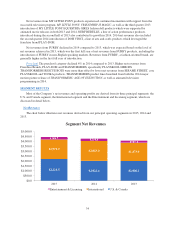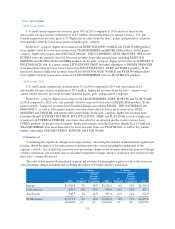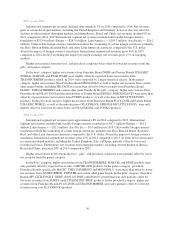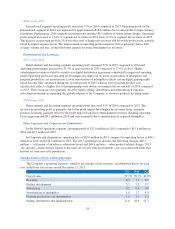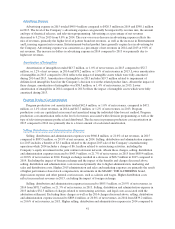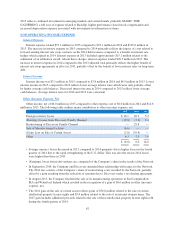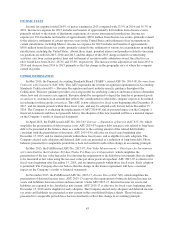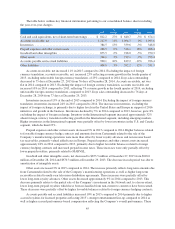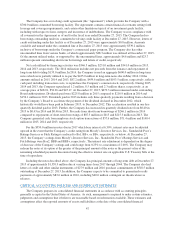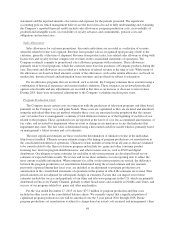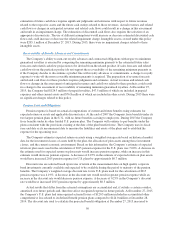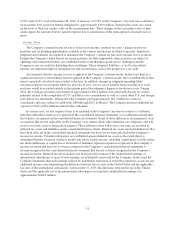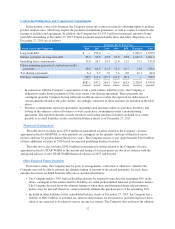Hasbro 2015 Annual Report Download - page 54
Download and view the complete annual report
Please find page 54 of the 2015 Hasbro annual report below. You can navigate through the pages in the report by either clicking on the pages listed below, or by using the keyword search tool below to find specific information within the annual report.
INCOME TAXES
Income tax expense totaled 26.0% of pretax earnings in 2015 compared with 23.5% in 2014 and 19.3% in
2013. Income tax expense for 2015 includes net benefits of approximately $4.0 million from discrete events,
primarily related to the statute of limitations expirations of various international jurisdictions. Income tax
expense for 2014 includes net benefits of approximately $20.0 million from discrete tax events, primarily related
to the effective settlement of certain open tax years in the United States and settlement of tax examinations in
certain jurisdictions, including Mexico. Income tax expense for 2013 includes net benefits of approximately
$30.0 million from discrete tax events, primarily related to the settlement of various tax examinations in multiple
jurisdictions, including the United States. Absent these items, potential interest and penalties related to uncertain
tax positions recorded in 2015, 2014 and 2013, and the impact of the 2013 charges related to restructuring
activities, exit from certain product lines and settlement of an unfavorable arbitration award, the effective tax
rates would have been 26.4%, 26.5% and 25.8%, respectively. The increase in the adjusted tax rate from 2013 to
2014 and decrease from 2014 to 2015 primarily reflect the change in the geographic mix of where the company
earned its profits.
OTHER INFORMATION
In May 2014, the Financial Accounting Standards Board (“FASB”), issued ASU No. 2014-09, Revenue from
Contracts with Customers (ASC 606). This ASU supersedes the revenue recognition requirements in Accounting
Standards Codification 605 — Revenue Recognition and most industry-specific guidance throughout the
Codification. This new guidance provides a five-step model for analyzing contracts and transactions to determine
when, how and if revenue is recognized. Revenue should be recognized to depict the transfer of promised goods
or services to customers in an amount that reflects the consideration to which the company expects to be entitled
in exchange for those goods or services. This ASU is now effective for fiscal years beginning after December 15,
2017, and for interim periods within those fiscal years, and may be adopted early but not before December 15,
2016. The Company is evaluating the requirements of ASU 2014-09 and its potential impact on the Company’s
financial statements and does not presently believe the adoption of this new standard will have a material impact
on the Company’s results or financial statements.
In April 2015, the FASB issued ASU No. 2015-03, Interest — Imputation of Interest (ASC 835-30), which
simplifies the presentation of debt issuance costs. ASU 2015-03 requires debt issuance costs related to long-term
debt to be presented in the balance sheet as a reduction to the carrying amount of the related debt liability,
consistent with the presentation of discounts. ASU 2015-03 is effective for fiscal years beginning after
December 15, 2015, and for interim periods within those fiscal years, and is eligible for early adoption. The
Company elected early adoption and deferred debt costs are presented as a reduction of long-term debt. Those
balances presented for comparable periods have been reclassified to reflect this change in accounting principle.
In May 2015, the FASB issued ASU No. 2015-07, Fair Value Measurement — Disclosure for Investments
in Certain Entities that Calculate Net Asset Value Per Share (or its Equivalent), which simplifies the
presentation of the fair value hierarchy by removing the requirement to include those investments that are eligible
to be measured at fair value using the net asset value per share practical expedient. ASU 2015-07 is effective for
fiscal years beginning after December 15, 2015, and for interim periods within those fiscal years. Early adoption
is permitted. The Company does not believe that the change in disclosure requirement will have a material
impact on the Company’s results or financial statements.
In November 2015, the FASB issued ASU No. 2015-17, Income Taxes (ASC 740), which simplifies the
presentation of deferred income taxes. ASU 2015-17 removes the requirement to bifurcate deferred income tax
assets and liabilities between current and non-current. Under ASU 2015-17, deferred income tax assets and
liabilities are required to be classified as non-current. ASU 2015-17 is effective for fiscal years beginning after
December 15, 2016 and is eligible for early adoption. The Company elected early adoption and deferred income
tax assets and liabilities are presented as non-current in the consolidated balance sheets. Those balances
presented for comparable periods have been reclassified to reflect this change in accounting principle.
43



